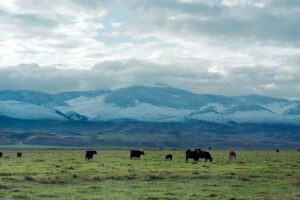There is a moment that comes to mind when recalling my short trip into the world of the enviropreneurs. Sitting on a paint mare whose name I can’t remember, atop a ridge in Emigrant, Montana. I had taken my urban backside out for a ride with Terry Anderson and his wife Monica to a place our wrangler called Death Valley. More of a narrow draw than a valley, it held the skeletons of two large animals lying in earthy bowls at the bottom. We were most likely looking at the bones of elk, according to Terry, brought down by a mountain lion and dragged to this private spot for undisturbed enjoyment.
At the top of Death Valley was the ridge where we stopped long enough to take in the thousands of acres that surrounded us, including mountains, trout streams, and timber stands. It was one of those vistas that make you wonder why you spend your time anywhere else. Even the clouds that would soon soak us had their charms. Wet but grinning, we loped back to the lodge. I returned a bit sorer, but also with a bit more context for the discussions about the environment and market forces that the enviroprenuers assembled from across the world would dig into that afternoon.
A month after that ride and accompanying discussions, the bonds that seemingly held those market forces together would dissolve. There would be chaos. At least for the folks who occupy Wall Street. Since returning from Montana, describing and unraveling that chaos has been the core of my work as a journalist. Forensic examinations of elk bones, have given way to dissections of credit default swaps. I wonder now, however, if one will ultimately affect the other.
Among the impassioned discussions and people gathered in Montana for those four days in September were John Tomlin and Carl Palmer. Tomlin (with the initial help of Palmer who was available as cheap labor while at Stanford’s Graduate School of Business) has started a venture capital fund called Conservation Forestry. Palmer has started Beartooth Capital. Unlike the VCs in Silicon Valley, these two investors don’t focus on unearthing promising iPhone applications or the world’s next great social network. Tomlin’s fund is focused on buying, restoring, preserving and ultimately selling timberland. Palmer’s fund does the same for ranchland. Both of these men believe they have identified gaps in the environmental sector that can be filled by creating new markets from which their funds can ultimately profit. Clearly their limited partners, the investors in the funds, believe the same.
The way it breaks down is fairly simple. Tomlin and Palmer identify land that is of value to a variety of stakeholders: timber buyers, cattle dealers, conservationists willing to pay to preserve that land, and developers eager to build a handful of swank homes or maybe a discreet lodge. The deals work by putting together those streams of revenue. Investors in the funds get paid back, in theory with some profit thrown in, when the land is resold. In some ways they are borrowing from other investment vehicles—including Real Estate Investment Trusts and Venture Capital funds, commodities funds, and land trusts—to come up with something entirely new.
What got me excited about this form of private equity investing is the opportunity for similar funds to spring up all over the world. You can imagine the same approach Tomlin and Palmer are pioneering being applied to other swathes of nature, including fisheries and coastal regions. The proof that their approach has legs will come when their investors get their first exit, which is to say, when the first project timber property or ranchland is resold for a profit.
That hasn’t happened yet. These funds are only a few years old, and remember traditional venture capital funds have seven- to ten-year lifespans during which the investors need to be patient. But the problem this nascent market faces is one of liquidity. These properties may turn out to be very illiquid, especially in the face of what has happened to markets. When most everyone is hoarding their cash, when commodity prices are crashing, both Tomlin and Palmer could be in for a long haul to return anything to investors.
The other way to look at it, however, might be that what Tomlin and Palmer are selling is exactly what the market is looking for—assets with real, transparent value. Would you like to bet what’s left of your money on some financial instrument that is exposed to who knows what convoluted fiscal gymnastics or on a stake in a world-class trout stream? Or, how about your own Death Valley, complete with a few elk skeletons? I know which I would take right about now.



